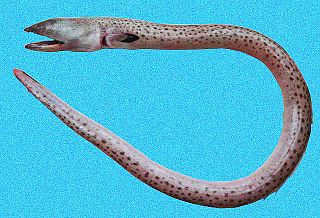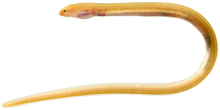
Ophichthidae is a family of fish in the order Anguilliformes, commonly known as the snake eels. The term "Ophichthidae" comes from Greek ophis ("serpent") and ichthys ("fish"). Snake eels are also burrowing eels. They are named for their physical appearance, as they have long, cylindrical, snake-like bodies. This family is found worldwide in tropical to warm temperate waters. They inhabit a wide range of habitats, from coastal shallows and even rivers, to depths below 800 m (2,600 ft). Most species are bottom dwellers, hiding in mud or sand to capture their prey of crustaceans and small fish, but some are pelagic.

The mottled eel, also known as the African mottled eel, the Indian longfin eel, the Indian mottled eel, the long-finned eel or the river eel, is a demersal, catadromous eel in the family Anguillidae. It was described by John McClelland in 1844. It is a tropical, freshwater eel which is known from East Africa, Bangladesh, Andaman Islands, Mozambique, Malawi, Sri Lanka, Sumatra, and Indonesia and recently from Madagascar. The eels spend most of their lives in freshwater at a depth range of 3–10 metres, but migrate to the Indian Ocean to breed. Males can reach a maximum total length of 121 centimetres and a maximum weight of 7,000 grams. The eels feed primarily off of benthic crustaceans, mollusks, finfish and worms.

Eels are ray-finned fish belonging to the order Anguilliformes, which consists of eight suborders, 20 families, 164 genera, and about 1000 species. Eels undergo considerable development from the early larval stage to the eventual adult stage and are usually predators.
The Pacific worm eel is an eel in the family Ophichthidae. It was described by David Starr Jordan and Charles Henry Gilbert in 1883. It is a marine, subtropical eel which is known from the eastern central and southeastern Pacific Ocean, including California, USA, Colombia, Costa Rica, El Salvador, Ecuador, Honduras, Mexico, Guatemala, Panama, Nicaragua, and Peru. It dwells at a depth range of 1 to 12 metres, and inhabits sand and mud sediments. Unlike many species of eel, it does not form burrows. Males can reach a maximum total length of 46 centimetres.
The Smallfin worm-eel is an eel in the family Ophichthidae. It was described by Charles Barkley Wade in 1946. It is a marine, tropical eel which is known from the eastern central and southeastern Pacific Ocean, including Nicaragua, Colombia, Panama and Costa Rica. It dwells at a depth range of 100 to 200 metres, and inhabits sediments of mud. Males can reach a maximum total length of 16 centimetres (6.3 in).
The Johnston snake eel, also known as the peppered worm eel in Micronesia and Hawaii is an eel in the family Ophichthidae. It was described by Leonard Peter Schultz and Loren Paul Woods in 1949. It is a marine, tropical eel, which is known from the Indo-Pacific region, including the Chagos Islands, Hawaii, the Marquesan Islands, the Society Islands, Australia, and New Caledonia. It dwells at a depth range of 2–23 m, and inhabits sand sediments in coral reefs. It can reach a maximum total length of 35 cm.
The dark throat worm eel is a species of eel in the family Ophichthidae. It was first described by Yusuke Hibino, Yoshiaki Kai, and Seishi Kimura in 2013. It is a marine, temperate water-dwelling eel which is known from Japan, in the northwestern Pacific Ocean. It dwells at a depth range of 90–147 metres. Males can reach a maximum total length of 26.5 centimetres.
The angry worm eel is an eel in the family Ophichthidae. It was described by Peter Henry John Castle and John E. McCosker in 1999. It is a tropical, marine eel which is known from the eastern Indian and western central Pacific Ocean, including India, Indonesia, the Straits of Malacca, northern Australia, and the Philippines. It is known to inhabit shallow, turbid estuaries, and to a lesser extent the deeper water over soft substrates. Males can reach a maximum total length of 29.6 centimetres.

Myrophinae, the worm eels, is a subfamily of ray-finned fishes belonging to the family Ophichthidae, which also includes the snake eels in the subfamily Ophichthinae.
Callechelys springeri, the ridgefin eel, is an eel in the family Ophichthidae. It was described by Isaac Ginsburg in 1951, originally under the genus Gordiichthys. It is a marine, tropical eel which is known from the eastern Gulf of Mexico, in the western Atlantic Ocean. It dwells at a depth range of 22 to 36 metres. Males can reach a maximum total length of 80.1 centimeters (31.5 in).

The spotted spoon-nose eel is an eel in the family Ophichthidae. It was described by John Richardson in 1848. It is a marine, tropical eel which is known from the western Atlantic Ocean, including North Carolina, USA, the northern Gulf of Mexico, and Brazil. It is known to dwell at a depth of 100 m (330 ft), and inhabits soft benthic sediments. Males can reach a maximum total length of 180 cm, but more commonly reach a TL of 150 cm.

Echiophis punctifer, the stippled spoon-nose eel, spoon-nose eel or snapper eel, is an eel in the family Ophichthidae. It was described by Johann Jakob Kaup in 1859. It is a marine, tropical eel which is known from the western and eastern Atlantic Ocean, including the Gulf of Mexico, Cuba, northern South America, Senegal, and Angola. It dwells at a depth range of 40 to 100 metres, and inhabits shallow bays and lagoons, in which it forms burrows in mud and sand. Males can reach a maximum total length of 180 centimetres (71 in), but more commonly reach a TL of 100 centimetres (39 in).
The Indifferent eel is a species of eels in the family Ophichthidae. It was described by John E. McCosker and James Erwin Böhlke in 1984. It is a marine, tropical eel which is known from the western central Atlantic Ocean, including Panama, Nicaragua, Suriname, and Texas, USA. It dwells at a depth range of 55 to 58 meters.
The Ordinary eel is an eel in the family Ophichthidae. It was described by Richard Heinrich Rosenblatt and John E. McCosker. It is a marine, subtropical eel which is known from a single specimen collected from a sandbank in the Gulf of California, in the eastern central Pacific Ocean, during low tide. From the holotype, it is known to reach a total length of 51 centimetres (20 in).
The Snack eel is an eel in the family Ophichthidae. It was described by Richard Heinrich Rosenblatt and John E. McCosker in 1970. It is a marine, subtropical eel which is known from a single specimen discovered in Mexico, in the eastern central Pacific Ocean. From the holotype, which was found in the stomach of a White seabass, males are known to reach a total length of 53 centimetres (21 in).
The Oriental worm-eel, also known as the Oriental snake eel, the Oriental sand-eel or the finny sand-eel, is an eel in the family Ophichthidae. It was described by John McClelland in 1844, originally under the genus Dalophis. It is a tropical, marine and freshwater-dwelling eel which is known from the Indo-Western Pacific, including Somalia, South Africa, India, Papua New Guinea, Tahiti, French Polynesia, Indonesia, Oman, Palau, New Caledonia, the Philippines, Sri Lanka, Seychelles, and Vanuatu. It dwells at a depth range of 0 to 3 metres, and forms burrows in sand and mud sediments in estuaries, rivers, and inshore turbid waters. Males can reach a maximum total length of 36 centimetres (14 in), but more commonly reach a TL of 25 centimetres (9.8 in).

The goldspotted eel, also known as the goldspotted snake eel or the dark-spotted snake eel, is an eel in the family Ophichthidae. It was described by Charles Alexandre Lesueur in 1825, originally under the genus Muraenophis. It is a marine, tropical eel which is known from the western and eastern Atlantic Ocean, including Bermuda, southern Florida, USA; the Bahamas, Santa Catarina, and Brazil. It dwells at a maximum depth of 15 metres (49 ft), and inhabits rocky and coral reefs. Males can reach a maximum total length of 110 centimetres (3.6 ft).
The longarmed snake eel is an eel in the family Ophichthidae. It was described by John E. McCosker and Richard Heinrich Rosenblatt in 1998. It is a marine, tropical eel which is known from the eastern central Pacific Ocean, including Mexico, Costa Rica, El Salvador, Guatemala, Nicaragua, and Panama. It is known to dwell at a depth range of 24 to 79 metres, and inhabits soft substrates. Males can reach a maximum total length of 27.4 centimetres (10.8 in).
Ophichthus melope is an eel in the family Ophichthidae. It was described by John E. McCosker and Richard Heinrich Rosenblatt in 1998. It is a marine, tropical eel which is known from the eastern central and southeastern Pacific Ocean, including Colombia and Costa Rica. It dwells at a depth range of 100 to 224 metres. Males can reach a maximum total length of 27 centimetres (11 in).
The Ornate snake eel is an eel in the family Ophichthidae. It was described by John Richardson in 1848, originally under the genus Ophisurus. It is a marine, tropical eel which is known from the eastern Atlantic Ocean, including Mauritania, St. Helena, and India. It inhabits the continental shelf, where it forms burrows in sand sediments. Males can reach a maximum total length of 90 centimetres (35 in).








